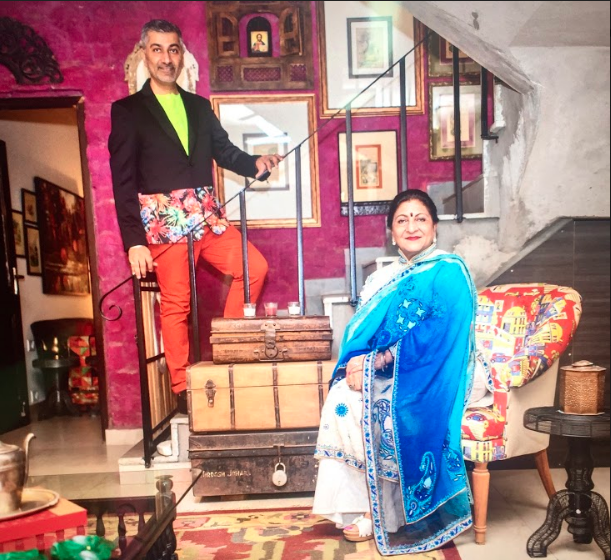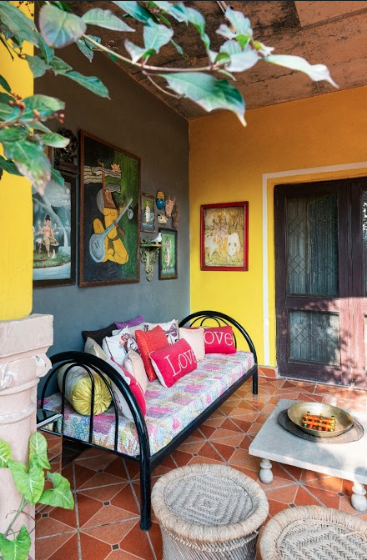Ever heard of Midas and his touch, turning all into gold? Now meet Manuu Mansheet, the designer with the Midas touch, who, with the swish of his hand, the dash of his brain, makes everything look picture perfect. People call him an interior stylist but I prefer the word ‘visual maestro’ who has an inner aesthetic scanner. He can walk into a room, find its design fault lines and set it right in a jiffy. Voila!
Visualiser, food stylist, design academic and a self-taught interior designer who has this inborn knack to ‘turn things around’, his design bastion is using heritage and making it look modern, liable and warm. Even a rare, vintage ‘Pichwai’, a ‘Jamevar’ throw, a precious ‘Pattachitra’ can blend in seamlessly into the classic environs he conjures. In this day and age, when the call to go local for vocal is turning everyone into clones of Indian, ethnic, we catch up with this cultural mixologist to find out how the twain meet in his design horizon.
A visiting faculty of visual merchandising in front running design schools like NIFT and Pearl, Manuu is a brave designer who takes on any design challenge. To him, the idiom ‘art has no boundaries’ holds true. Hence at the wedding of Ambani’s daughter, you found him doing up the favor corner as a heritage store calling it the Swadeshi Bazaar. At the famed Diacolor-Chaudhary wedding, he was busy styling food at a vibrant, experiential chaat corner. “Indian weddings are like James Bond thrillers. They call for all the frills, fancies and the shenanigans but it all flashes by in jiffy,” says Manuu.




He humbly submits, “My journey so far took me from being an amateur stylist to a professional one. Growing up on Indian mythological stories, the famous comics and many more rooted art influences, naturally made me gravitate towards the purest of arts, Tanjores, Pattachitras, Pichwais, Tangkhas, Urdu calligraphy, Catholic iconography… the list can go on endlessly. Even the design elements I source are Indian in their technique and historic reference: wood work, lacquer work, carpets, durries, metal work, textiles, jamawars.”
The delicate shift from ethnic Indian to classic contemporary happens in the way Manuu curates the entire look of a space which might be modern but never a replica of a New York studio apartment or a minimalist, Norwegian home. He says, “I have never understood (not that I condemn it or look down upon it) the need to ape the West. The newfound and newfangled theories of interior design, use of glass, steel and foreign materials; these and jacketed, non-aired (windows not allowing fresh air) air-conditioned havens, leather sofas and large minimalist spaces.”
Instead Manuu, in his many design journeys including the visual merchandising for acclaimed brands like Ikea, Godrej and Boyce, Taj Khazana, Tata Westside, goes for rooted maximalism, classic contemporary. Not just in the choice of elements but also the entire zoning of design, the pantone shades he carefully selects, the textures, materials and props. He says, “A lot of clients these days come up with inspirational pictures from Pinterest and other sources and think that the same colours and textures that were used in in- fancy houses in Manhattan or Mykonos or Paris or London would look great in Delhi also. India is a diverse country. It’s got different regions, different states, different cultures, different weathers and different seasonal conditions. Our diversity is our essence.”
He goes on to say, “We have our own inherent styles which are unique to various cultures and states. India is a land of colours and artisans and textiles. There is a lot to learn and still discover in various rural and urban areas then why must we ape the west? Why must we look for inspirations elsewhere when there is so much more available within our country? I do not agree that all the colours and all the designs and the style of living in different parts of the world can be incorporated in India.”
Associated with Tata’s craft project, Taj Khazana for years, Manuu had the good fortune to work with masters of ‘hand- made’ in India up close. What thrilled him in this experience was the skilled way in which even an artisan living in a distant village was able to adapt his technique to a newer dialect. He says, “Creativity is not a destination. It is a process which keeps evolving with time. India has gone through its own journey with regards to its motifs, colours, product design etc. Design has its own shelf life. Hence you will still see the use of Kutchi mirror work, miniature art, Tanjore and various other textile forms embroideries and embellishment but the entire interpretation is subtle, contemporary and a paradigm shift from its ancient avatar. India can no longer be associated with snake charmers, elephants, the bindi or the sari. India’s stance today on the world map as a producer of world-class art products textiles jewels etc these need not be ethnic village centric or rustic if I may say so.”
Talking on the need to go vocal for locals, he suggests that first we need to make all those marvellous products we export available to the Indian consumer. “ It surprises me when I go abroad and I see products at Crate & Barrel, restoration hardware, Ikea etc. which are made in India yet we do not see them in our own country even more appalling is when I get to see homes here designed with products from China and the Middle East,” he adds.
“We live in a country where artisans are ready to produce whatever we like, whether it’s a frame, a piece of furniture, metalwork, a lamp ,an accessory. Having said that using traditional art forms needn’t take us through the ethnic route. Our artisans need a little bit of handholding and they are capable of producing amazing products that perfectly fit our contemporary way of life,” says Manuu. And this mastery over the two realms, one rooted and the other euphemistic modern is best portrayed in his Delhi home that is like walking into a candy store for design sore eyes. Picture perfect, lived in and full of art, some rare some rooted but always divine.













